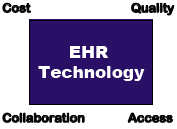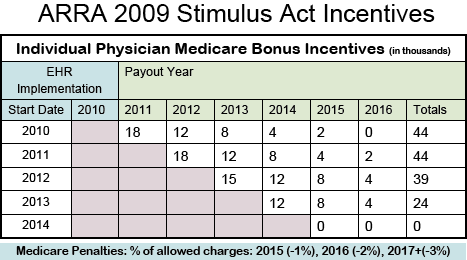This spring, I traveled extensively to Washington, D.C., for a variety of reasons, mainly to advocate on behalf of chiropractic physicians as our government initiates massive health care reform efforts.
The conference, sponsored by the Agency for Healthcare Research and Quality, has historically been limited to hospital and allopathic audiences. This year's group was expanded for the first time to include other health care experts, and I was the designee from the chiropractic profession. My goal and commitment to the profession remains clear: I want to ensure that the interests of chiropractic physicians are considered in any and all discussions related to policy-making for health care information technology. And in the case of HL-7, chiropractic participation is critical so the concerns of our profession with regard to the development of HIEs will be heard.
The catalyst for broadening this conference audience was presumably the economic stimulus package, formally known as the American Recovery and Reinvestment Act (ARRA) of 2009, which includes more than $19 billion to fund the introduction of electronic health records in every physician office in America. The section of the ARRA that deals specifically with this appropriation is the HITECH Act, which outlines the requirements for funding eligibility. To be qualified for incentive payments offered through the legislation, doctors must adopt qualified EHRs that have the functionality to communicate with HIEs, making the standards by which HIEs are governed extremely important and elevating the prominence of interfacing capabilities with other systems.
I'll discuss more about the requirements for incentive payments later in this article, but the main reason I share my involvement with the creation of health care information technology standards is to demonstrate how the general health care industry is finally opening its arms to the chiropractic profession. We've been dancing on the periphery for years, but finally, we are gaining recognition as an essential component of health care delivery and actively participating in these important discussions regarding policy, standards and reform.
Reform = Collaboration + Technology
Speaking of reform, during that same visit to D.C., I also met with Sen. Tom Harkin's staffers as well as government relations personnel from the American Chiropractic Association to discuss the evolving model of reform for our health care system. As I shared in a previous column, elements of several models are under consideration including the Medical Home Model, which relies heavily on collaboration among health care professionals in order to improve the quality of patient care. Harkin and several of his colleagues are outlining a comprehensive national health care reform plan we can expect to be introduced later this year.
The cornerstone of that plan will be collaboration, and the framework to support collaboration will be driven by technology. While many uncertainties still remain, these two elements are certain. And with collaboration at the forefront, Harkin and others understand that chiropractic physicians and other nonmedical providers are an integral element of national reform. The reform movement is committed to supporting true wellness, something doctors of chiropractic have been preaching for years.
Now it's time for us to rise to the occasion and continue walking our talk, while we have people watching us and listening. The first step in walking the talk is adopting EHRs. Why? Because technology will create the path to collaboration by assisting case management through registries, database queries, instant access to information, alerts and reminders, and all the related tools the digital age provides us. We need technology to form the health care teams that will improve patient care for every American.
With the anticipated health care reform model so heavily reliant on technology, those who do not adopt an EHR will be left out of the health care framework. In fact, the government is emphasizing the critical role an EHR will play in successful reform so heavily that it is funding the digital transition in its entirety. In order to adapt to the new model of health care, we must adopt an EHR. Since the government will pay for our EHR (up to $44,000 for each physician), we're simply being asked to fund the energy and effort to implement it. Seems like more than a fair deal to me.
How to Access Your $44,000 Incentive
As I mentioned earlier, the process to fund your EHR is structured through incentive payments to physicians who adopt such systems. Not all health care professionals will be eligible for incentive payments, but doctors of chiropractic are an approved group, as they are covered by the Social Security code defining physicians, which the ARRA is using as its definition.
Two major areas will be evaluated by our government when determining payment approvals. First, the EHR system must be qualified, and second, the system must be used meaningfully by the chiropractic physician. A qualified EHR system must have the capacity to handle patient demographics and clinical health information, and also must have clinic management capabilities, as outlined by the entity that certifies qualified EHR. Only a certified EHR system will be eligible. The certifying body has not yet been announced, but the industry anticipates that the Certification Commission for Healthcare Information Technology (CCHIT) will be the likely choice since it was approved in 2006 by the government's Office of the National Coordinator of Health Care Information Technology and Medicare to manage such efforts.
The second requirement, "meaningful use," is determined by three important measures: (1) connectivity to health information exchanges and other EHR systems so they can share information when authorized by the patient; (2) regular reporting of quality measures to the Centers for Medicare & Medicaid Services (CMS), including capturing outcome assessments and performance of pain assessments; and (3) e-prescribing capability. Because we don't have prescribing privileges, it is unknown at this time whether this will remain a requirement for doctors of chiropractic. With regard to reporting requirements, the general structure of the plan suggests that reporting of quality measures will likely be managed by the PQRI (Physicians' Quality Reporting Initiative), a standardized mechanism that already exists.
As much as $44,000 can be paid as an incentive to a doctor for investing in a qualified EHR system. And in clinics with multiple physicians, each physician can qualify for the incentives, as long as the aforementioned terms are met. And while we know that CMS will be involved, its specific role is still being evaluated with regard to reporting and eligibility requirements for doctors participating in the incentive program. For example, minimum billing thresholds such as an annual $25,000 in covered services to CMS are being considered in order to be eligible for the incentive payments. However, there is some discussion on consideration for proportionate payments if the threshold is not met. So, if you average 16 Medicare patient visits a week, you would likely qualify. I will follow-up on this issue in a future article once the policies and standards relating to the Department of Health and Human Services and Medicare have been formally released.
To access the full $44,000, which is paid through Medicare in stages (four annual installments starting in 2011), the EHR system has to be qualified and used in a meaningful way starting in 2010. To clarify the timing, it is necessary to explain PQRI's influence on the process. PQRI, which is expected to oversee reporting requirements, currently requires reporting on at least 80 percent of patients. To accommodate this requirement, the EHR system would need to be in use for the majority of the year prior to the first incentive payment, assuming adherence to PQRI standards will be required. Hence, EHR implementation in 2010 is necessary in order to receive an $18,000 first payment in 2011 and maximize the incentives available.
For new users, implementation of an EHR system typically requires 90 days to six months. Given the expectation that meaningful use will be necessary for the better part of 2010 in order to get a 2011 incentive payment, the implementation process for chiropractic physicians should begin promptly in 2009. Those who had the vision to implement a qualified EHR and can demonstrate meaningful use are already eligible for the full incentive payments.
Penalties for Not Transitioning to EHR
 The Evolving Health Care Landscape: Technology Front and Center
Those who choose not to transition to an EHR system will be penalized beginning 2015 and continuing through 2018. These penalties will be assessed through a reduction in your Medicare claims reimbursement on services billed. To further motivate adoption, some states have already passed laws that mandate EHR use after 2014 in order to attain a license to practice or to renew a license, concurrent with the stimulus plan. With financial and legal ramifications in play, the incentives to adopt an EHR now are enormous.
The Evolving Health Care Landscape: Technology Front and Center
Those who choose not to transition to an EHR system will be penalized beginning 2015 and continuing through 2018. These penalties will be assessed through a reduction in your Medicare claims reimbursement on services billed. To further motivate adoption, some states have already passed laws that mandate EHR use after 2014 in order to attain a license to practice or to renew a license, concurrent with the stimulus plan. With financial and legal ramifications in play, the incentives to adopt an EHR now are enormous.
The Reform Cube
Given the benefits the government is providing chiropractic physicians, it is a wonder that any of us are still waiting to implement EHR. If the financial incentives are not enough motivation, doctors of chiropractic must consider what role they will play in the health care reform cube. Our health care landscape will soon shift to a different model; consider a cube in which quality, cost, and delivery of care through collaboration and access exist at each point, while technology sits squarely in the middle. Technology improves quality by offering reminders, alerts and other assistive techniques; technology lowers costs by reducing duplication of services; and technology improves collaboration and access by providing a mechanism to share patient health information across all providers. All of this allows for a robust clinic management system.

As chiropractic physicians, we strive to improve quality, we seek to reduce costs, and we crave the opportunity to collaborate on the health care team, so the cube is the ideal home for us. When we adopt the proper technology, we gain not only substantial financial support, but also membership in the cube. And isn't membership what we've been asking for from the health care community all these years? This membership is not for the sake of privilege, but for the sake of having other providers refer patients to receive the benefit of chiropractic care, achieve wellness, and experience cost-effective and efficacious care naturally. Accept the invitation now - it won't be offered again.
Click here for previous articles by Steven Kraus, DC, DIBCN, CCSP, FASA, FICC.





